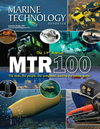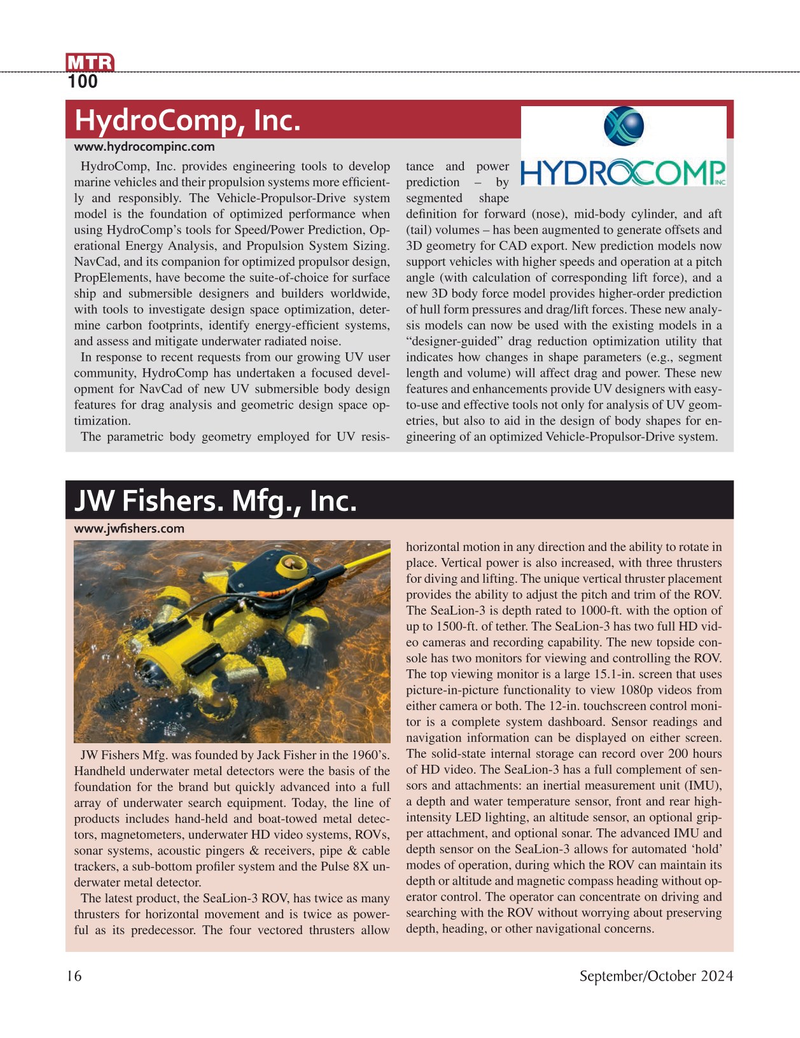
Page 16: of Marine Technology Magazine (September 2024)
Read this page in Pdf, Flash or Html5 edition of September 2024 Marine Technology Magazine
MTR 100
HydroComp, Inc.
www.hydrocompinc.com
HydroComp, Inc. provides engineering tools to develop tance and power marine vehicles and their propulsion systems more ef? cient- prediction – by ly and responsibly. The Vehicle-Propulsor-Drive system segmented shape model is the foundation of optimized performance when de? nition for forward (nose), mid-body cylinder, and aft using HydroComp’s tools for Speed/Power Prediction, Op- (tail) volumes – has been augmented to generate offsets and erational Energy Analysis, and Propulsion System Sizing. 3D geometry for CAD export. New prediction models now
NavCad, and its companion for optimized propulsor design, support vehicles with higher speeds and operation at a pitch
PropElements, have become the suite-of-choice for surface angle (with calculation of corresponding lift force), and a ship and submersible designers and builders worldwide, new 3D body force model provides higher-order prediction with tools to investigate design space optimization, deter- of hull form pressures and drag/lift forces. These new analy- mine carbon footprints, identify energy-ef? cient systems, sis models can now be used with the existing models in a and assess and mitigate underwater radiated noise. “designer-guided” drag reduction optimization utility that
In response to recent requests from our growing UV user indicates how changes in shape parameters (e.g., segment community, HydroComp has undertaken a focused devel- length and volume) will affect drag and power. These new opment for NavCad of new UV submersible body design features and enhancements provide UV designers with easy- features for drag analysis and geometric design space op- to-use and effective tools not only for analysis of UV geom- timization. etries, but also to aid in the design of body shapes for en-
The parametric body geometry employed for UV resis- gineering of an optimized Vehicle-Propulsor-Drive system.
JW Fishers. Mfg., Inc.
www.jw? shers.com horizontal motion in any direction and the ability to rotate in place. Vertical power is also increased, with three thrusters for diving and lifting. The unique vertical thruster placement provides the ability to adjust the pitch and trim of the ROV.
The SeaLion-3 is depth rated to 1000-ft. with the option of up to 1500-ft. of tether. The SeaLion-3 has two full HD vid- eo cameras and recording capability. The new topside con- sole has two monitors for viewing and controlling the ROV.
The top viewing monitor is a large 15.1-in. screen that uses picture-in-picture functionality to view 1080p videos from either camera or both. The 12-in. touchscreen control moni- tor is a complete system dashboard. Sensor readings and navigation information can be displayed on either screen.
JW Fishers Mfg. was founded by Jack Fisher in the 1960’s. The solid-state internal storage can record over 200 hours
Handheld underwater metal detectors were the basis of the of HD video. The SeaLion-3 has a full complement of sen- foundation for the brand but quickly advanced into a full sors and attachments: an inertial measurement unit (IMU), array of underwater search equipment. Today, the line of a depth and water temperature sensor, front and rear high- intensity LED lighting, an altitude sensor, an optional grip- products includes hand-held and boat-towed metal detec- tors, magnetometers, underwater HD video systems, ROVs, per attachment, and optional sonar. The advanced IMU and sonar systems, acoustic pingers & receivers, pipe & cable depth sensor on the SeaLion-3 allows for automated ‘hold’ modes of operation, during which the ROV can maintain its trackers, a sub-bottom pro? ler system and the Pulse 8X un- depth or altitude and magnetic compass heading without op- derwater metal detector.
The latest product, the SeaLion-3 ROV, has twice as many erator control. The operator can concentrate on driving and searching with the ROV without worrying about preserving thrusters for horizontal movement and is twice as power- ful as its predecessor. The four vectored thrusters allow depth, heading, or other navigational concerns.
16 September/October 2024
MTR #7 (1-17).indd 16 10/3/2024 12:31:22 PM

 15
15

 17
17
